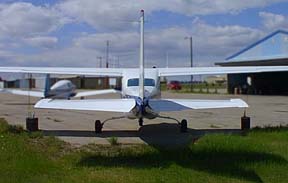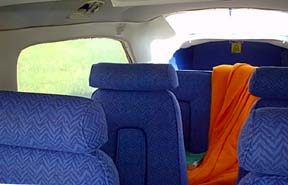 |
| FTLComm - Tisdale - June 15, 1999 |
|
| Allan Stuckel of Lake Lenore is the owner of this example of the heaviest light single
aircraft. The Cessna 210 went into production in 1960 as a six seat big brother of
the 182 and with its retractable landing gear was an
excellent aircraft but in 1967 Cessna went to the cantilever strut less wing and
the modern Centurion became the ultimate private aircraft. This one is a 1977 version
and was imported into Canada in 1978 making its home at Lake Lenore since 1980. The
Continental Teledyne engine in this aircraft is actually rated at 285 horse power
but because this machine is turbocharged it has 310 |
 horse power
available at take off which can send its maximum take off weight of nearly 4,000
pounds into the air in a take off roll of only 2,160 feet. Mr. Stuckel's aircraft
has an empty weight of 1,723 kilograms. horse power
available at take off which can send its maximum take off weight of nearly 4,000
pounds into the air in a take off roll of only 2,160 feet. Mr. Stuckel's aircraft
has an empty weight of 1,723 kilograms.
Once airborne this cross country machine can climb to a service ceiling of 27,000
feet and take its passengers 869 miles at a cruise speed of 226 miles per hour. Its
fuel capacity is 90 US gallons.
Despite the performance of this bird it still behaves like a Cessna and stalls at
67 miles per hour which means it needs 1,500 feet of run way to land. |
| In 1978 Cessna produced a pressurised version of this aircraft which eliminated the
need for a qualified pilot and his or her passengers to wear oxygen masks. This was
considered a major technological breakthrough at the time as it offered a pilot to
make those over the weather cross country flights in comfort but there was a downside
to this as the aircraft and its capabilities taxed even the best most experienced
pilots as he or she was now essentially operating at airliner conditions. |
 |
 |
| When ever we add complexity to a machine we automatically increase the potential
for serious problems. The editor of Flying magazine flew one of these for years and
more then once this top rated pilot found himself with more tension then he needed
and once a blown alternator made his flight down right uncomfortable. |
Cessna created a remarkable aircraft in the 210 with folding gear and even the step
retracts. Starting in 1979 Cessna no longer installed the main landing gear doors
on its 210s saving weight and not affecting performance while improving the length
of time needed to cycle the gear.
Later models even were fitted with air conditioning, deicing and radar. Pilots of
all versions of the 210 have to really keep ahead of a machine that cruises along
at over 200 miles an hour.
This version is fitted out with Cessna's standard radio system of 1977. This was
a solid stack and includes two VHF and VOR radios, an ADF and Cessna's auto pilot.
You will notice on the panel picture below that a bracket is attached to the pilot's
column for his GPS (Global Positioning) With the exception of the folding gear most
Cessna jockeys would |
 |
| have no problem transitioning to this aircraft. But, it would have to be flown below
12,000 unless the pilot had his or her |
 IFR (instrument
flight rules) rating. IFR (instrument
flight rules) rating.
When you consider that this is the Cessna Cadillac you realise that when you put
out the kind of money this aircraft is worth you had better upgrade your capabilities
to go with the machine's performance.
The value of a Cessna 210 can very considerably because of the equipment and the
service hours on the machine. Aircraft with struts are priced between $64,000 US
and $100,000. Turbo versions like this one sell for $130,000 to more then $200,000.
(all values in US dollars) The average prices for this model is around $170,000. |
| This nose on view of the Turbo 210 shows of its new three blade propeller as this
machine is ready once again to take to the air. |
 |

 horse power
available at take off which can send its maximum take off weight of nearly 4,000
pounds into the air in a take off roll of only 2,160 feet. Mr. Stuckel's aircraft
has an empty weight of 1,723 kilograms.
horse power
available at take off which can send its maximum take off weight of nearly 4,000
pounds into the air in a take off roll of only 2,160 feet. Mr. Stuckel's aircraft
has an empty weight of 1,723 kilograms.


 IFR (instrument
flight rules) rating.
IFR (instrument
flight rules) rating. 